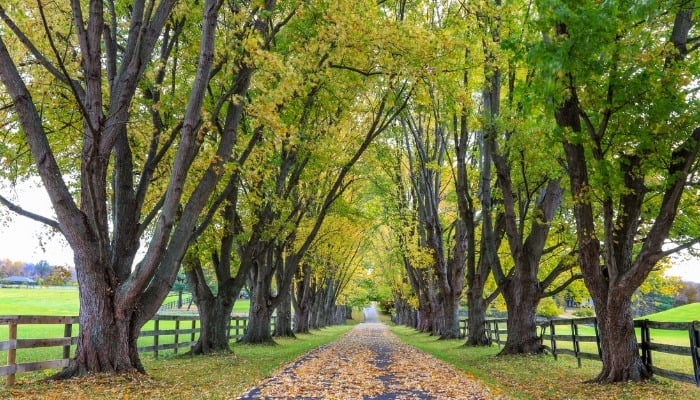If you want to enhance the appearance of your home, choosing the appropriate type of tree to include in your landscaping plan can make a significant difference, particularly if you intend to create a row of trees along a lengthy or curving driveway.
From ornamental and shade trees to trees that provide your home with a formal and sophisticated look, there are dozens of excellent tree types from which to choose.
With so many options, it can be difficult to know what tree will perform best in your particular climate, as well as what tree will give you the look you’re trying to achieve.
Additionally, it is important to think about whether or not you would like to line your driveway with deciduous or evergreen trees.
Deciduous trees, such as oak and maple, shed their leaves in the fall while evergreen trees, such as pine, will maintain their color all year long.
Each type of tree comes with a list of maintenance requirements and characteristics.
Generally speaking, any tree you choose should be planted between 3 to 8 feet away from your driveway’s edge, depending on how large the tree will be once it is fully mature.
This will avoid cracked pavement due to tree roots.
You should space trees approximately 1 ½ times the spread of the mature tree to avoid overcrowding while remaining visually pleasing.
Now that you’re a little more familiar with the basic requirements of selecting a tree type for your driveway, take a look at the following list of our favorites.
1. Bradford Pear (Pyrus calleryana)

Bradford pear trees, also known as Callery pear, are stunning to look at year round.
In the spring they explode with a display of showy white flowers, and they hold onto their brilliant autumn color for a long time.
From appearance alone, they would make a marvelous addition to your driveway. Bradford pears are deciduous trees that can grow up to 60 feet tall.
The tree produces dark, glossy leaves and small, sterile brown fruits that are commonly eaten by birds. Typically they will grow in a domed or conical shape.
These trees grow best in USDA Zones 5 through 9 and prefer full sun. They tolerate most soil types and can handle periods of drought or heavy rain.
Some parts of the United States consider the Bradford pear to be an invasive species.
If you are interested in lining your driveway with a host of Bradford pear trees, be sure to check with your local ordinances first.
2. Serviceberry (Amelanchier canadensis)

The serviceberry is considered a small deciduous tree and a large shrub that can grow up to 25 feet with a spread of 25 feet once fully grown.
In March and April, this tree produces clusters of small, delicate white flowers. In the fall, it erupts in a glorious display of red and gold.
Serviceberry trees also produce a reddish-black berry that typically ripens in late June. Birds of all kinds enjoy these berries.
Serviceberry trees prefer a minimum of four hours of direct sunlight a day. They grow best in moist, acidic, well-drained soil in USDA Hardiness Zones 4-8.
3. Honey Locust (Gleditsia traicanthos var. inermis)
Also referred to as the thornless honey locust, this large shade tree has a glorious yellow-green canopy that would look stunning planted along a driveway.
This tree produces pinnately compound leaves that are 8 inches long and consist of up to 14 leaflets. In the springtime, they also produce beautiful and fragrant yellow-green flowers.
This is a particularly easy, tolerant, and fast-growing tree that loves full sun. It grows well in both wet and dry soil and can withstand a variety of weather and pollution-like stresses.
You will find success with this tree if you live in USDA Zones 3-9.
4. Italian Cypress (Cupressus sempervirens)

Italian cypress trees are fast-growing evergreens that would lend a level of sophistication and formality to any driveway.
They have a long, elegant silhouette that typically grows up to 50 feet tall and 3 feet wide if left to their own devices.
It grows best in warm, full sun climates found in USDA Zones 8-10. The trees work well in tight, compact spaces.
5. Leyland Cypress (x Cupressocyparis leylandii)

Another popular evergreen choice to line your driveway is the leyland cypress. This tree has a slender shape and produces dense blue-green foliage.
It is a fast-growing tree that can reach heights of 120 feet and widths of 25 feet.
The leyland cypress prefers full sun conditions and can grow in a wide range of soils, including acidic, loamy, moist, sandy, and well-drained clay. It grows best in USDA Zones 6-10.
6. Eastern Red Cedar (Juniperus virginiana)
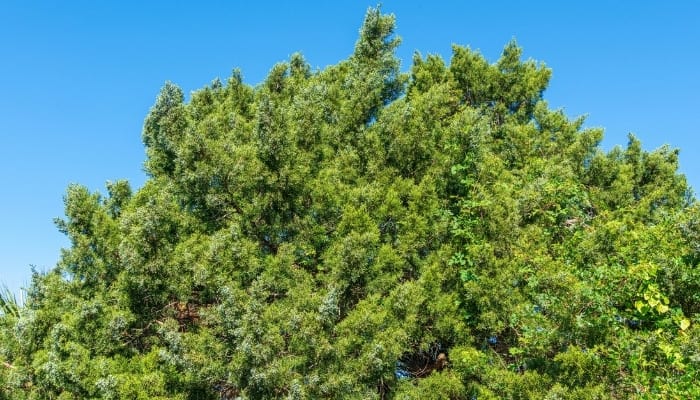
The Eastern red cedar is a lovely evergreen that grows in a pyramid-like shape from 30 to 65 feet.
It produces medium-green colored foliage and blue-green fruits that look like berries but are cones. They are large trees that make excellent windbreakers.
Eastern red cedar trees are full-sun trees that can tolerate a wide range of weather and climate stressors.
They grow in a large number of soil types from acidic to alkaline and fair best in hardiness zones 2 to 9.
7. Juniper (Juniperus communis)

There are many varieties of juniper, including the Spartan juniper, Skyrocket junipers, Moonglow juniper, and Taylor juniper with common Juniper growing up to 20 feet tall.
Generally speaking, juniper trees are elegant evergreen trees with dense green foliage and attractive bright-blue berries.
Juniper trees grow in USDA Zones 3-9. As a result, they can grow in a variety of soil types. They prefer partial shade to full sun.
8. Ginkgo (Ginkgo biloba)

Ginkgo biloba trees, also referred to as maidenhair trees, are large dioecious trees native to Japan and China. When they reach maturity, the trees are between 50 to 80 feet tall with a canopy of up to 40 feet.
They have unique, fan-shaped leaves. In the fall, these leaves turn a brilliant golden-yellow color and would make a stunning arrangement along a driveway.
In the United States, these trees grow best in USDA Zones 4-9.
They don’t have a soil type preference, although they do best in well-drained sandy soil. Partial shade to full sun will see the tree perform best.
9. Crepe Myrtle (Lagerstroemia indica)

The deciduous crepe or crape myrtle tree is a 9 to 25 foot tall ornamental, flowering tree with beautiful pink flowers.
The blooms have a wrinkled appearance that resembles crepe paper and attract a range of bees and birds.
These trees have lovely gray bark that contrasts nicely with the yellows, reds, and oranges of the foliage in the fall.
Crepe myrtles can tolerate a variety of growing conditions in USDA Zones 6-9. They are full-sun plants that like heat and moist, well-drained soils.
10. Red Maple (Acer rubrum)

Red maples are excellent border trees that provide a bright burst of color in spring, summer, and fall. Although they bloom in the springtime, they show off with brilliant red and yellow foliage in the fall.
They can grow up to 60 feet tall and have a pleasant oval shape. In addition, they are valuable homes and food sources for wildlife.
Red maples like acidic, well-drained soil and do best in USDA Zones 3-9.
11. Birch (Betula pendula)

Birch trees would make a lovely addition along any driveway. There are many different varieties, including Silver birch, River birch, and Himalayan birch.
Some varieties are large shade trees with wide canopies, while others are taller and more narrow.
Birch trees typically have a grayish silver bark. They do well in full sun and like acidic, alkaline, loamy, sandy, and moist, well-drained soil types. You can find this tree in Zones 3-7.
12. Emerald Green Aborvitae (Thuja occidentalis ‘Smaragd’)

The narrow, pyramid-shaped evergreen trees have a deep-green color that looks beautiful in any season.
They grow slowly and have dense foliage that makes them excellent windbreakers and border plants when planted between 2 to 3 feet apart.
They do well in hardiness zones 2-7 and prefer full sun. The Emerald Green variety of Thuja does best in acidic, sandy, rich, and well-drained soils.
13. Plum (Prunus americana)

Fruit trees make excellent border plants due to their relatively small size and shape. There are many varieties of plum trees, but most prefer full sun and well-drained soil.
If you want the trees to produce fruit, they need at least six hours of sun per day. Plum trees grow best in Zones 3-8.
14. Dogwood (Cornus spp.)

Dogwood trees are one of the most magnificent blooming trees and can grow up to 30 to 40 feet tall.
It has dense green foliage, and in the spring it produces showy white and pink blooms that last for almost four weeks. In the fall, the trees turn a bright scarlet.
There are 11 varieties in America alone, including the Brown dogwood, flowering dogwood, and the Pacific dogwood.
Most species of dogwood grow well in Zones 5 through 9. They are full-sun trees that like acidic, clay, and well-drained soil.
15. Rose of Sharon (Hibiscus syriacus)

Rose of Sharon is a beautiful deciduous tree that usually has multiple trunks.
The foliage is dark green, and they produce trumpet-shaped flowers that show up in white, pink, red, and shades of purple.
Rose of Sharon isn’t picky when it comes to soil type, although moist and well-drained soil will help it grow best. They grow best in full sun in zones 5-9.
They only grow to a height of 12 feet with a width of 10 feet at full maturity.
16. Chinese Elm (Ulmus parvifolia)
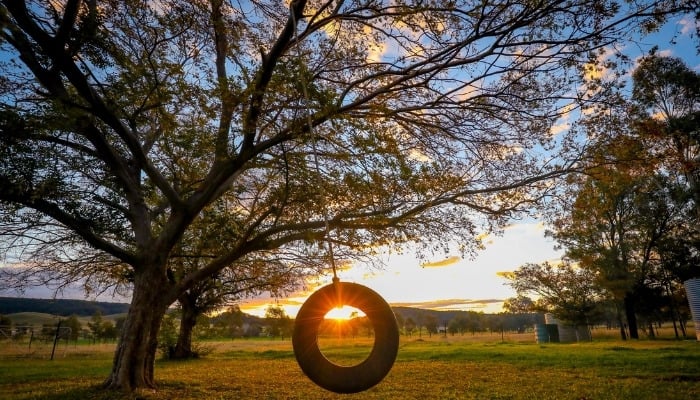
Chinese elms, also known as lacebark elm, are graceful deciduous trees with colorful red and gray bark. They can grow up to 50 feet tall when they mature.
Their foliage has a leathery feel and a sharp, single-tooth shape that turn a range of bright colors from August to November.
You can find Chinese elm growing in Zones 4-9. The trees themselves don’t grow very tall, but they have a wide canopy that provides plenty of shade.
17. Crabapples (Malus spp.)

Crabapples are flowering ornamental trees that have glossy leaves, beautiful blooms, and lovely visual appeal.
There are many varieties of crabapple trees, including the Prairifire and the Snowdrift. The trees are also disease resistant.
Crabapples produce small fruits that are less than 2 inches in diameter. They attract a wide range of wildlife, particularly deer.
The tree grows best in Zones 3-8. They need at least six hours of sunlight per day and love acidic, moist, well-drained soils.
18. American Beech (Fagus grandifolia)
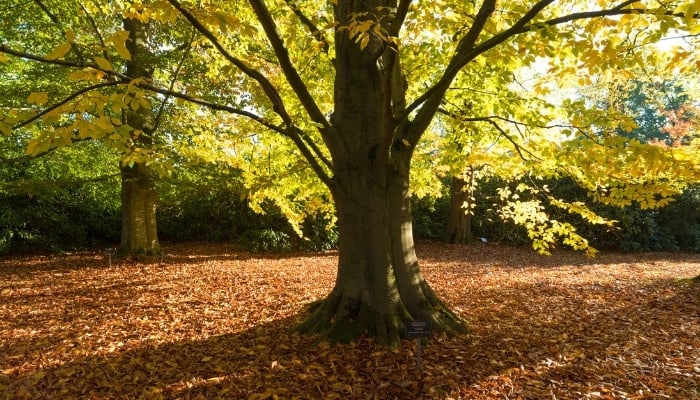
American beech trees make a lovely border tree. They are slow-growing shade and ornamental trees that have a widespread canopy, and at full growth can measure 50 to 80 feet.
The leaves are roughly 6 inches long and have a narrow shape that comes to a sharp point. In the fall, the American beech trees turn fiery shades of orange and yellow.
These fast-growing trees grow 12 to 24 inches a year. They like full sun and grow well in most soil types, including well-drained, clay, and acidic soils. They are also drought sensitive.
You can find this tree in Hardiness Zones 4-9.
19. Zelkova (Zelkova serrata)
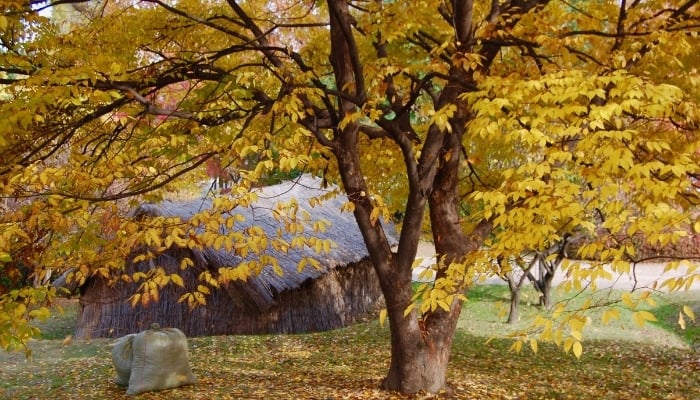
The Japanese Zelkova is an upright tree similar to the American elm with a vase shape and a round canopy.
Standing at up to 80 feet tall, they are shade trees frequently found in commercial landscaping, boulevards, and parking lots.
They have medium-green serrated leaves that experience a wide range of fall shades. The bark on these trees is also lovely. As the tree matures, the bark peels back, revealing a deep orange color.
Zelkova trees love moist, well-drained soil and a pH of around 7.5. These trees are a little finicky, and should not be pruned or planted in the late fall or winter.
Zelkova thrive in Hardiness Zones 5-8.
20. Weeping Willow (Salix alba)

The weeping willow is a beautiful and graceful tree that is quite recognizable. It has long branches that sweep the ground and have light-green, narrow leaves.
In the spring, the tree produces little yellow flowers. Weeping willows can grow to be nearly 100 feet tall.
Weeping willows grow in Hardiness Zones 6-8 and prefer at least four hours of sunlight per day. They are commonly found near water, although they are fairly drought tolerant.
These trees don’t mind acidic or alkaline soils, and can also grow in loamy, sandy, clay, or moist soil types.

